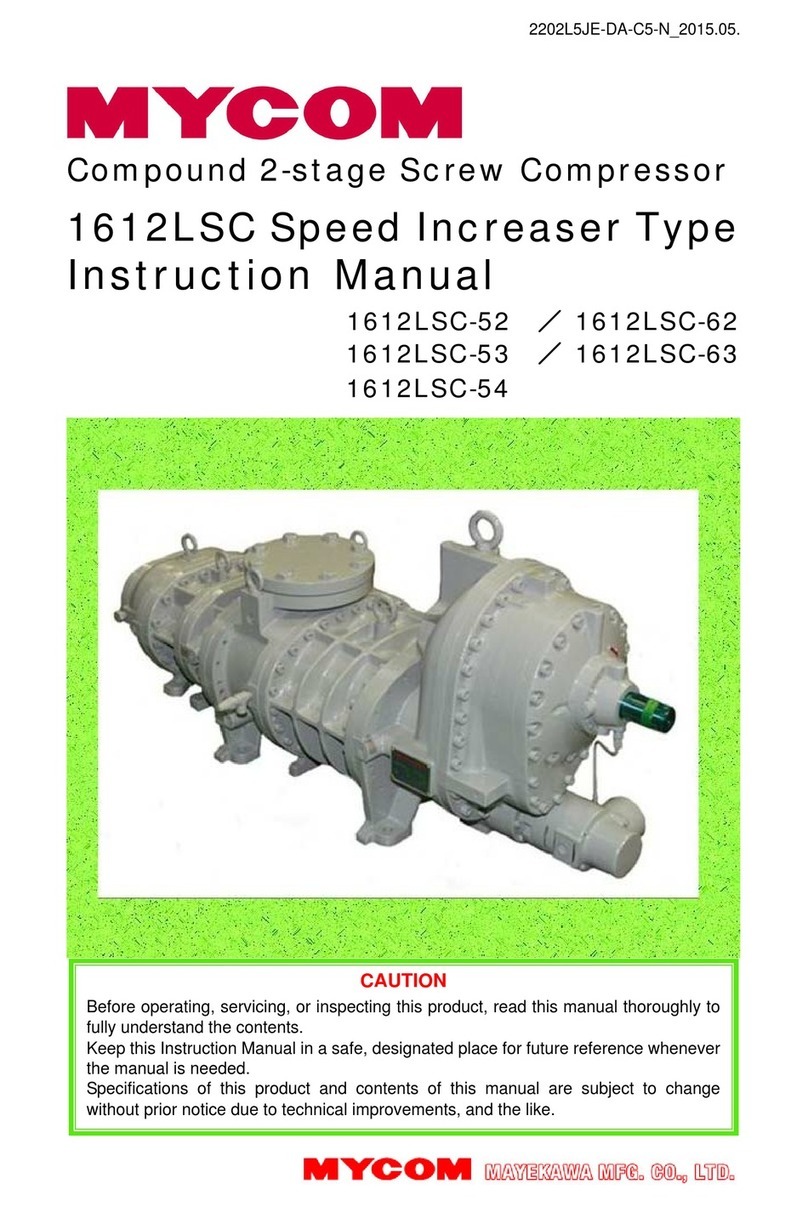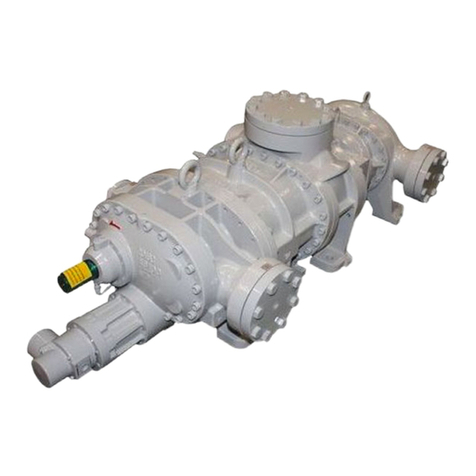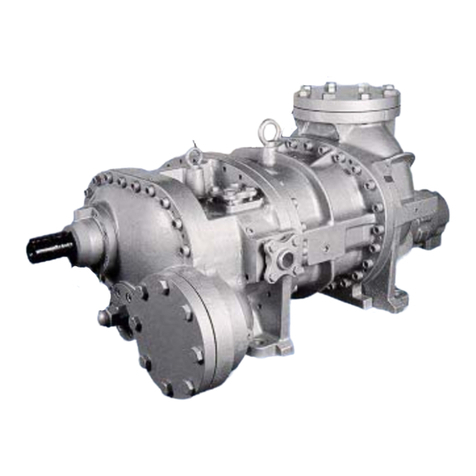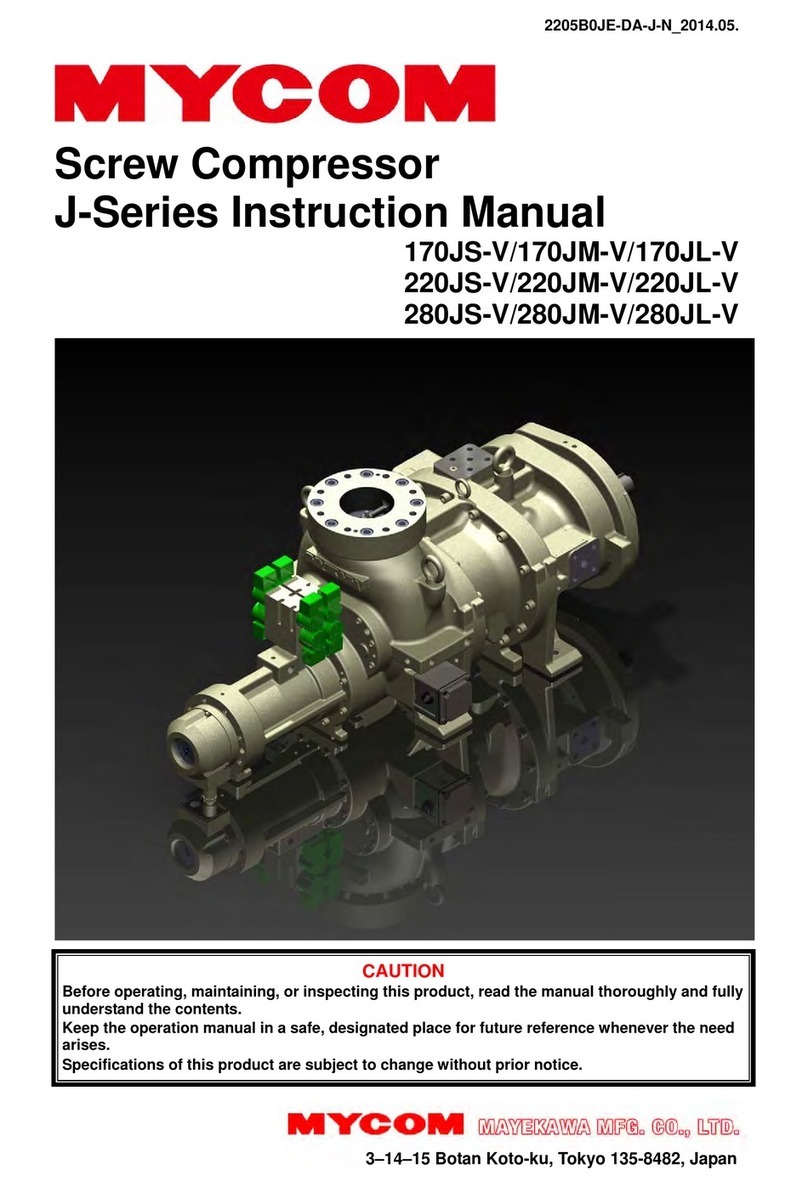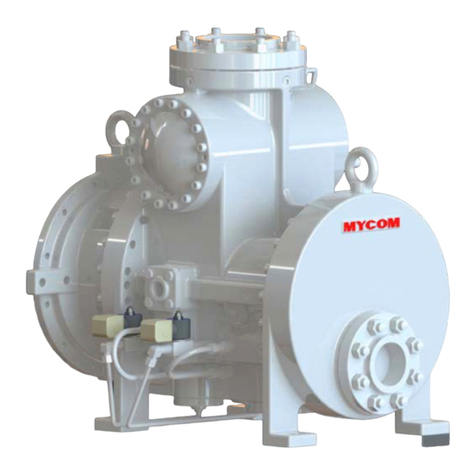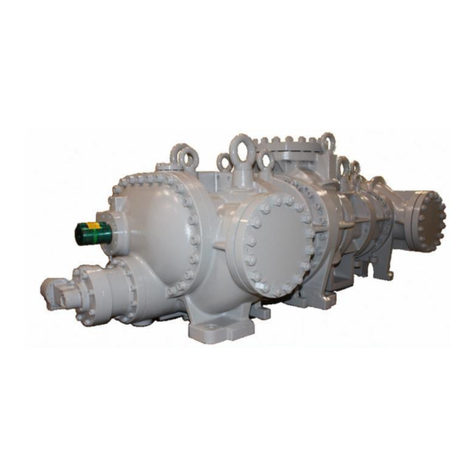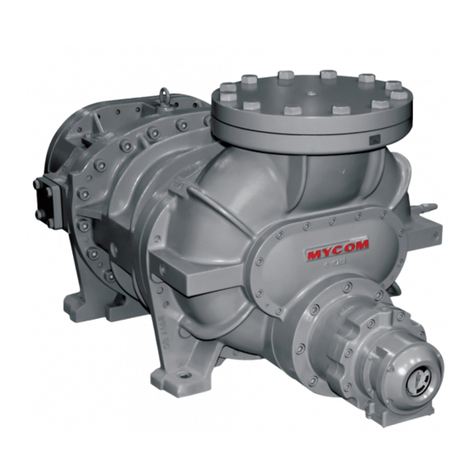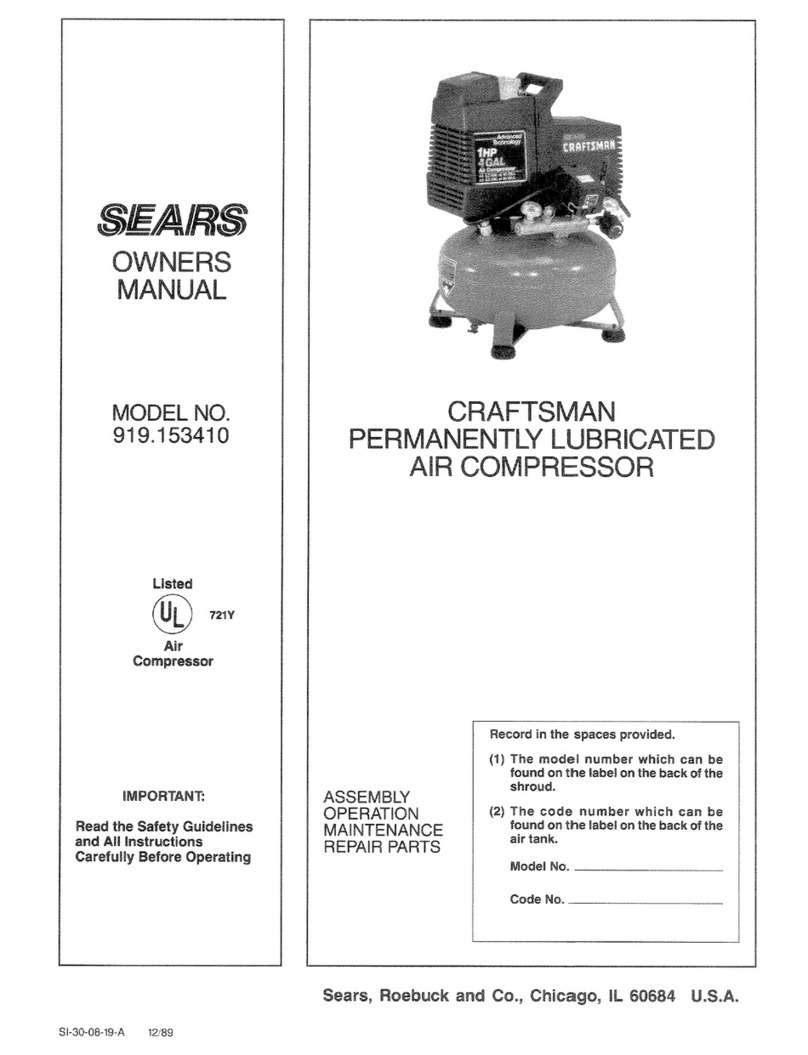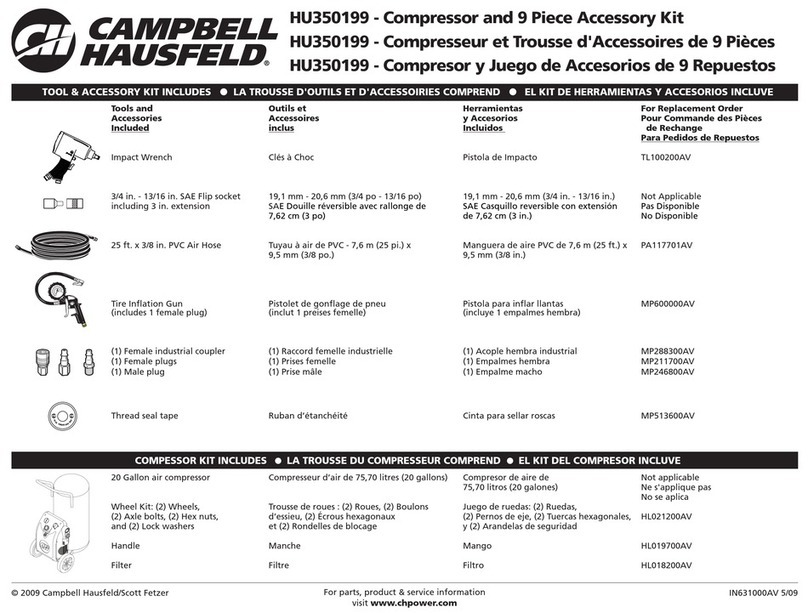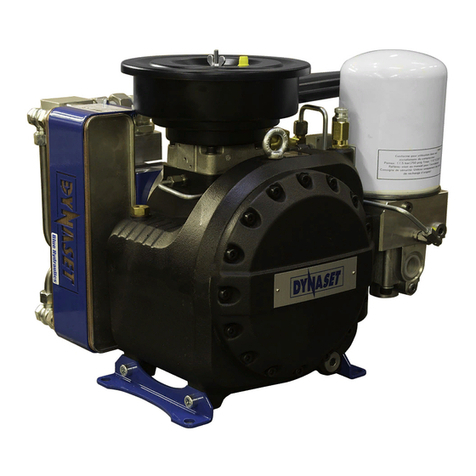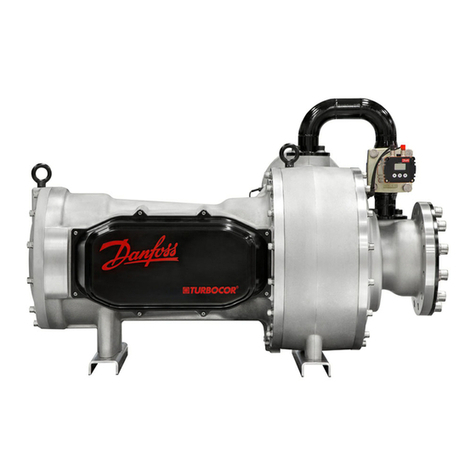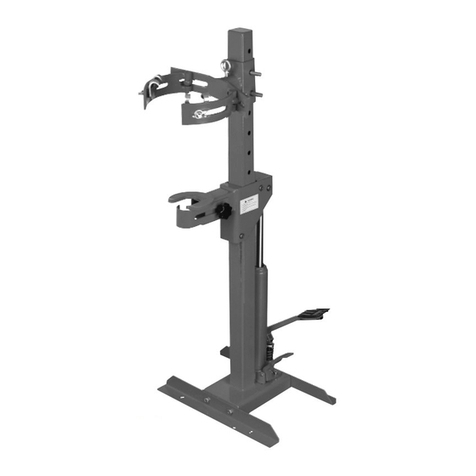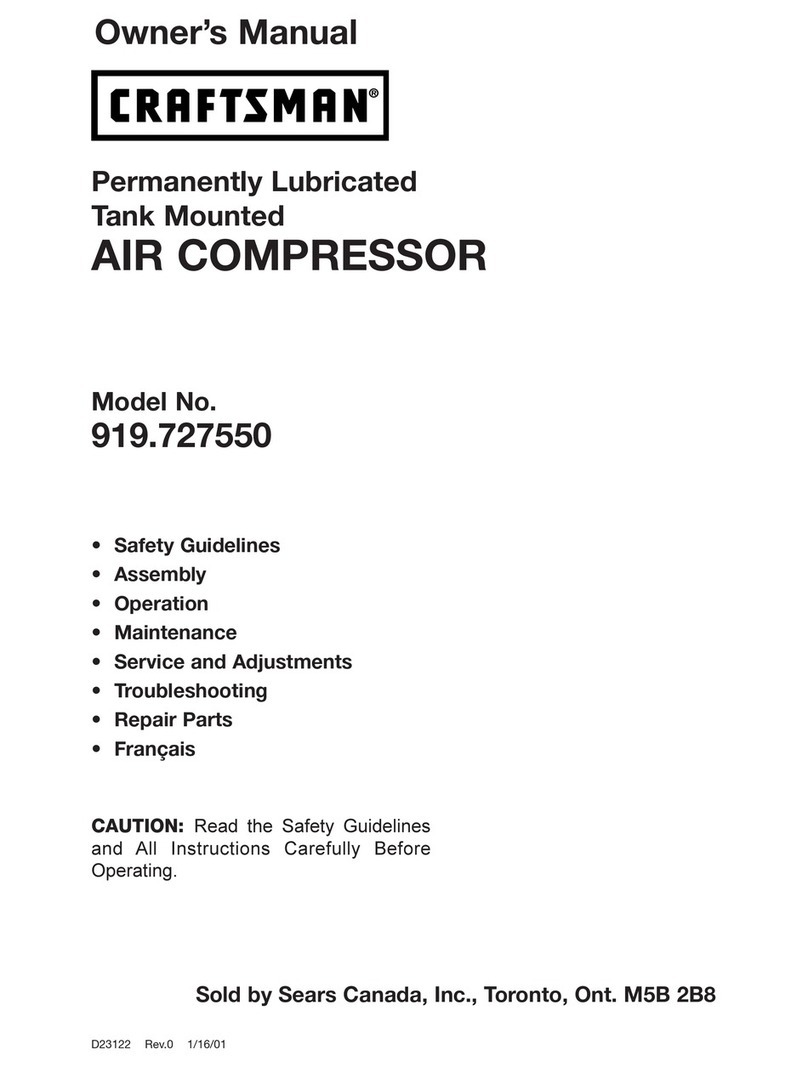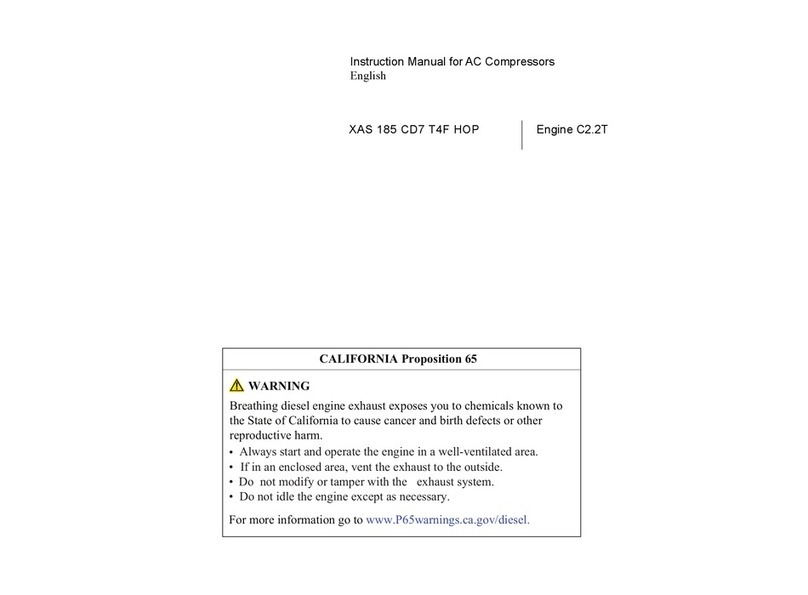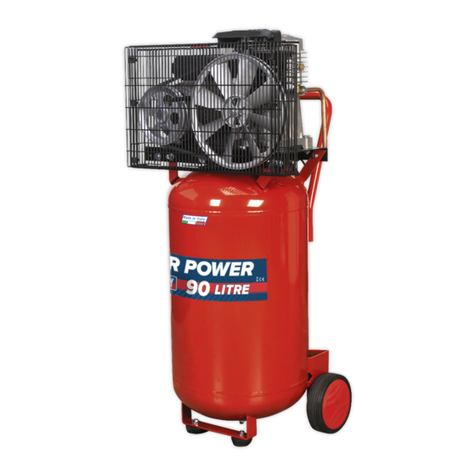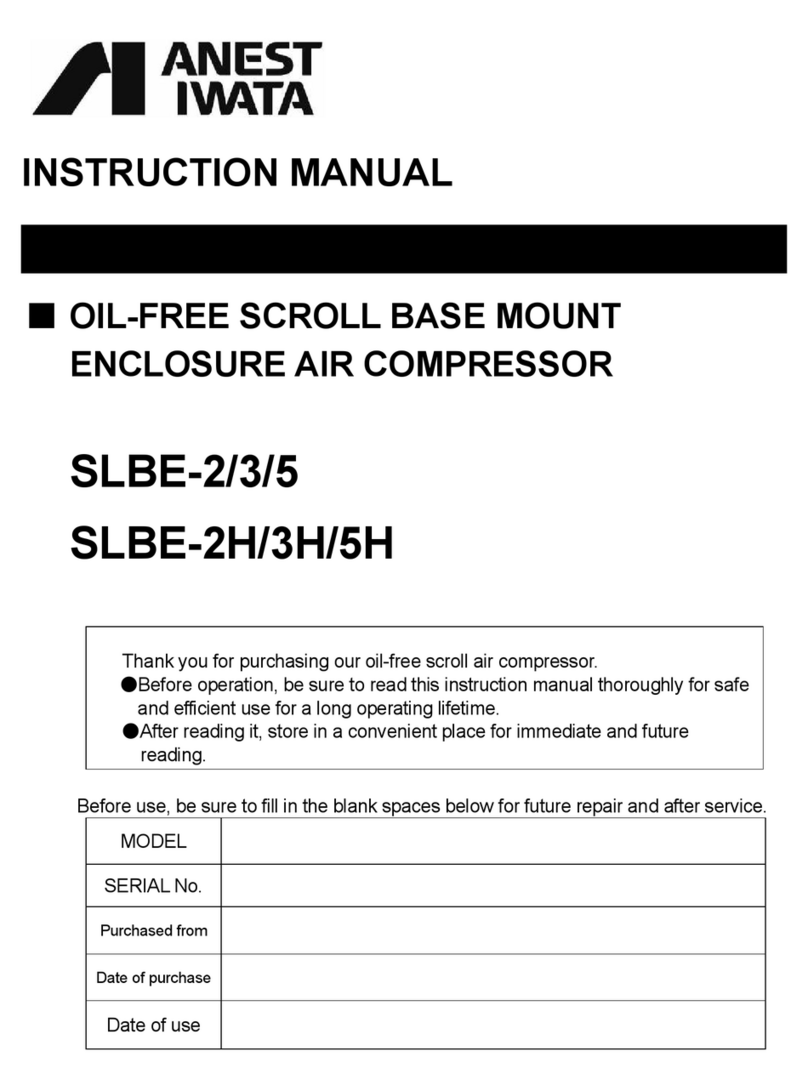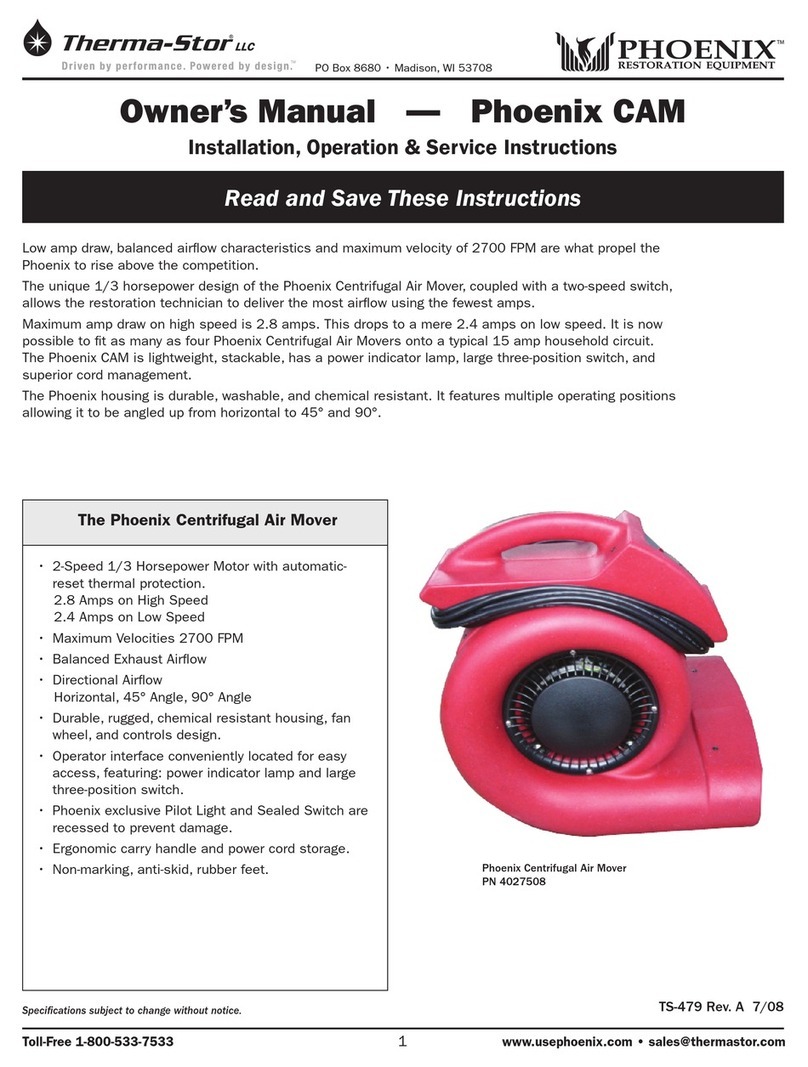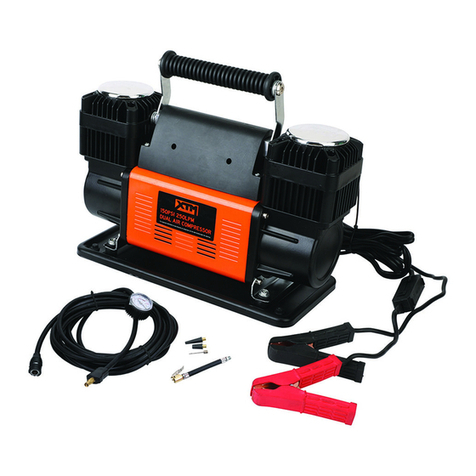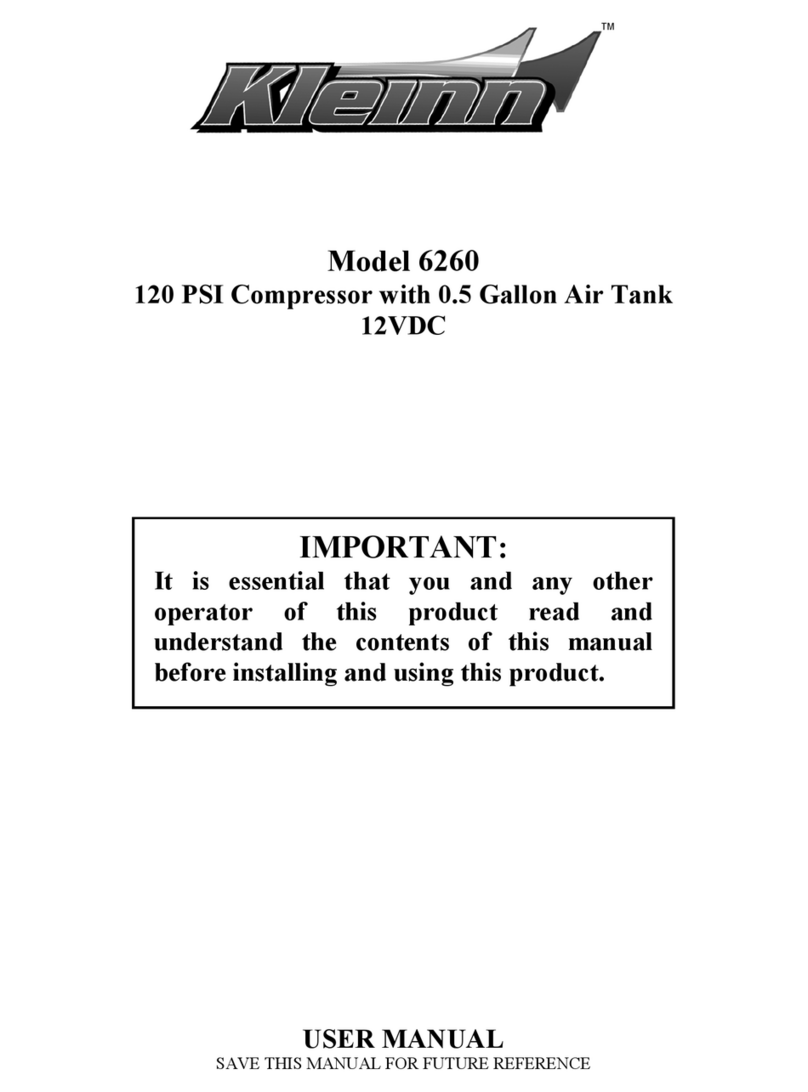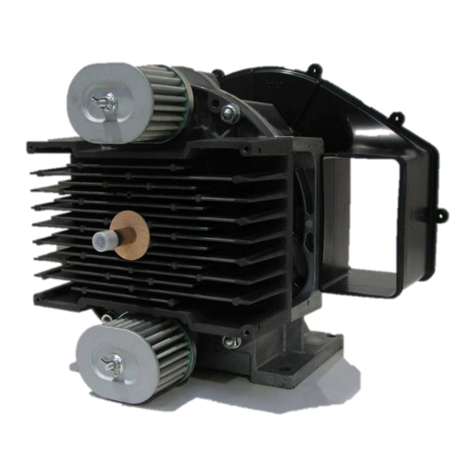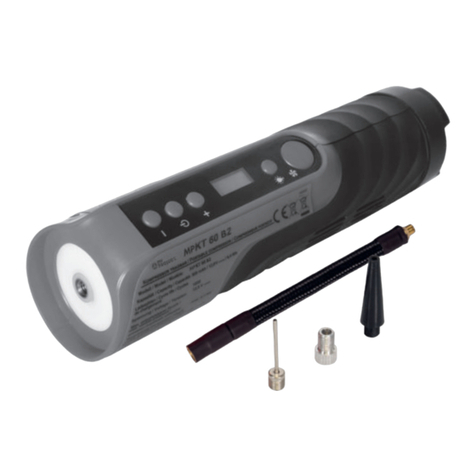mycom UD Series User manual

2200X2JE-MY-S2-N_2020.09.
UD-series Screw Compressor
Instruction Manual
CAUTION
Read this manual carefully and thoroughly before operating, maintaining or inspecting this
product. It is important to fully comprehend the contents of this manual. Keep the operation
manual in a safe, designated place for future reference whenever the need arises.
Specifications of this product are subject to change without prior notice.
125SUD/125LUD
160SUD/160MUD/160LUD
200SUD/200MUD/200LUD
250SUD/250MUD/250LUD
320SUD/320MUD/320LUD/320LLUD
400SUD/400MUD/400LUD/400LLUD/
400XLUD

Preface
UD-series Screw Compressors
i
Preface
Thank you for purchasing the UD-series/screw compressor (hereinafter referred to as
"this product").
This instruction manual (hereinafter referred to as "this manual") describes safety information,
operational and detailed maintenance procedures for safe and effective use of this product、It is
applicable to the following compressor types
125SUD, 125LUD, 160SUD, 160MUD, 160LUD, 200SUD, 200MUD, 200LUD, 250SUD, 250MUD,
250LUD, 320SUD, 320MUD, 320LUD, 400SUD, 400MUD, 400LUD, 400LLUD, 400XLUD
Before installing or using this product, make sure you read this manual.
Keep this manual in a safe place near this product for quick reference whenever needed.
Revision History
Title of Instruction Manual Document No. Date of Initial Issue
UD series Instruction Manual 2200X2JE-MY-S2-N_2020.09. September, 2020
Rev. No.
Issue Date Revision Details Prepared/Approved by
00 Sep. 03, 2020 Completely revised by re-issuing as electronic version
and Document number change Takita/ Muta

Warranty and Disclaimer
UD-series Screw Compressors
ii
Warranty and Disclaimer
Warranty Clauses
If malfunctions or damages occur under proper usage and conditions following documents such as
specifications or instruction manual of this product, or, if MAYEKAWA judges that malfunctions or
damages are related to design or manufacture of the product, and if the malfunctions or damages are
within the warranty period, MAEKAWA will repair this product or replace parts without any charges.
The warranty period is “12 months from factory shipment of this product”. However, if any separate
agreement has been concluded, such an agreement will have the priority in principle.
Disclaimer Clauses (Exclusion of Warranty Clauses)
Please note that we disclaim any responsibility for malfunction and/or damage to this product in case of
the following incidents:.
Malfunction or damage of this product caused by force majeure such as windstorm, intense
rainfall, flood, tidal wave, earthquake, land subsidence, thunderbolt, fire, etc.
Malfunction, damage, or defect to this product due to abuse or misuse such as storing this
product outdoors or in hot and humid locations, operation with excessive liquid flow-back and
start-and-stop.
Malfunction or damage caused by devices or equipment not provided by MAYEKAWA
including operation control methods of those devices or equipment.
Malfunction or damage due to operation of this product outside the operation limits as
described in this manual.
Malfunction or damage caused by the usage of refrigerants, gases, and/or lubricants which
are not approved by MAYEKAWAfor this product as described in this manual.
Malfunction or damage caused by maintenance or inspection procedures which are not
recommended by MAYEKAWA.
Malfunction or damage caused by parts which are not MAYEKAWA genuine.
Malfunction or damage caused by parts which are not MAYEKAWA genuine.
MAEKAWA shall not be liable to buyer for any incidental, indirect, special or consequential
damages that buyer may suffer in relation to this product.

Important Information
UD-series Screw Compressors
iii
Important Information
Intended Use of this Product
This product is a screw compressor intended use for freezing and refrigeration.
Do not use this product for any other purposes for which it is not intended or deviate from the
specifications which are described in Chapter 2, Article 2.3 “Compressor Specifications”.
The maintenance service should be performed according to the procedures described in this manual.
Always pay attention to perform the works in a safe manner and working environment.
Important Information for Safe Use of This Product
Although MAYEKAWA has paid a lot of attention to safety measures for this product, all hazards
including potential hazards caused by human errors, or due to environmental conditions can not be
anticipated.
There are guidelines that must be followed to ensure proper use of this product. However, the warnings
in this manual and safety labels on this product are not all inclusive. When operating the product, pay
extreme caution on personnel safety as well as on items described in this manual or required by
common safety practice.
Important rules for safety work with the product that apply to all workers including managers and
supervisors are listed below.
Before using this product, carefully read and fully understand the contents written in this manual and
pay attention to safety.
Operation, maintenance, and inspection of this product should be performed by qualified
personnel educated about the fundamentals of the product and trained about hazards
involved and measures to avoid danger.
Do not allow any person other than those educated on the fundamental expertise of the
product and trained about hazards involved and measures to avoid dangers to approach the
product while it is operating or during maintenance.
Observe all related federal/national and local codes and regulations.
To prevent accidents, do not carry out any operation or maintenance other than those
described in this manual, or use the product for any unapproved purpose.
Replace the parts with the genuine parts.
Not only workers but also managers should actively participate safety and health activities in
the workplace to prevent accidents.
When closing or opening valves during work, apply lockout/tagout without failure, to prevent
the valves from closing or opening accidentally during the work.
[Lockout] To lock with a key in order to keep people, except the workers involved, from
operating the product.
“Lockout” is a safety procedure to make sure that machines or equipment are property shut off and
not able to be started up again by locking the power source to them.
Lockout is not just simply turning off the switches to stop the power supply, but includes immobilizing
them with a key or similar device to prevent unauthorized access.
Lockout devices are devices such as keys, covers, and latches, to immobilize and shut-off switches,
valves, opening and closing levers, etc.
[Tagout] To prevent any inappropriate work by hanging tag plates indicating like “work in
progress”.
“Tag-out” means to clearly indicate that a device is in lockout and that operation of the device is

Important Information
UD-series Screw Compressors
iv
prohibited. The sole purpose of the tag plates such as prohibition of operation or commissioning is to
warn others that it is prohibited to operate the locked out product. It should always be accompanied by
a suitable lockout device to make operation impossible.
Observe the following precautions when performing maintenance work on electrical control.
Electrical maintenance of the product must be performed by certified/qualified personnel and
only those who have been trained in the potential danger and its avoidance relevant to the
electrical control of the product.
Before servicing or inspecting the electrical equipments or devices, turn "OFF" the motor main
power and control power, and perform lockout/tagout to prevent the power from being turned
on during work.
During maintenance work, make sure that the power supply on the power source side is shut off and
perform lockout/tagout to prevent the product from being accidentally turned on.
About this Manual
This product may be modified without prior notice. Therefore, the appearance of actual
machine may differ from the descriptions in this manual. If you have any questions contact
your sales offices or service centers. For each sight of MAYEKAWA, refer to following URL.
http://www.mayekawa.com/about/network/
This manual is in English. If any other language is required it is the customers responsibility to
prepare a manual for safety education and operation instructions.
This manual is copyrighted. Drawings and technical references including this manual shall not,
in whole or part, be copied, photocopied, or reproduced into any electronic medium or
machine-readable form without prior permission from MAYEKAWA.
Photographs or drawings included in this manual may differ from the appearance of actual
product.
If this manual is lost or damaged, immediately place a purchase order to your local sales office
or service center for a new manual. Using the product without the manual may result in safety
issues.
In the event that this product or the compressor package is resold, don’t forget to supply this
manual together with the product.
Construction of this Manual
Title of section and
chapter
Description details
Preface Describes the outline of this manual and how to read it.
Warranty and Disclaimer
Describes clauses and coverage of warranty.
Exemption of warranty clauses is described as disclaimer.
Important Information
Describes important information related to this product and this
manual.
1. Safety
Describes safety information for the worker, safety rules for this
product, and management details regarding wor
k safety required for
handling the product.
2. Structure and Specifications
of the Compressor
Describes the main components of this product, functional
information, specifications, and operating limits.
3. Installation
Describes installation procedure of this product.
4. Compressor and Package
Operation
Describes precautions for operating this product.

Important Information
UD-series Screw Compressors
v
Title of section and
chapter
Description details
5. Maintenance and Inspection
Describes sections and period for inspecting, disassembly and
assembly of the product.
6. Troubleshooting
Describes troubleshooting methods for the product in case problems
occur during operation of the product.
7. Related Documents
Describes documents such as illustrated parts breakdown and parts
list.

Table of Contents
UD-series Screw Compressors
vi
Table of Contents
Preface........................................................................................................................i
Revision history.....................................................................................................i
Warranty and Disclaimer ...........................................................................................ii
Warranty Clauses.................................................................................................ii
Disclaimer Clauses (Exclusion of Warranty Clauses)...........................................ii
Important Information...............................................................................................iii
Intended Use of this Product............................................................................... iii
Important information for Safe Use of this Product.............................................. iii
About this Manual...............................................................................................iv
Construction of this Manual.................................................................................iv
Table of Contents......................................................................................................vi
Chapter 1 Safety
1.1 Observation/Prevention.............................................................................1-1
1.1.1 Observance (Do’s).............................................................................................. 1-1
1.1.2 Prohibitions (Don’ts) ........................................................................................... 1-3
1.2 Warnings.....................................................................................................1-4
1.2.1 Types and Meanings of Warnings...................................................................... 1-4
1.2.2 Safety labels ....................................................................................................... 1-4
1.3 Residual Risks............................................................................................1-6
1.4 Safety Devices............................................................................................1-9
1.4.1 Emergency Stop Button...................................................................................... 1-9
1.4.2 Breakers for the Main Motor Power and Control Power..................................... 1-9
1.4.3 Compressor Protection Devices ....................................................................... 1-10
Chapter 2 Compressor Specifications and Structure
2.1 Features of UD-series Screw Compressors .............................................2-1
2.2 Model Designation of the Compressor .....................................................2-2
2.3 Compressor Specifications .......................................................................2-4
2.3.1 Standard Specifications...................................................................................... 2-4
2.3.2 Operation Limits.................................................................................................. 2-5
2.3.3 Outer Dimensions and Weight............................................................................ 2-7
2.4 Compressor Structure and Mechanism..................................................2-10
2.4.1 Overview of UD-series Screw Compressor......................................................2-10
2.4.2 Refrigerant Gas Compression Mechanism....................................................... 2-11
2.4.3 Internal Volume Ratio Vi................................................................................... 2-13
2.4.4 Bearings and Balance Piston............................................................................ 2-17

Table of Contents
UD-series Screw Compressors
vii
2.4.5 Shaft Seal ......................................................................................................... 2-17
2.4.6 Capacity Control ............................................................................................... 2-17
2.4.7 Oil Supply Route............................................................................................... 2-17
Chapter 3 Installation
3.1 General Installation Precautions...............................................................3-1
3.2 Installation Works.......................................................................................3-1
3.2.1 Unpacking........................................................................................................... 3-1
3.2.2 Storage ............................................................................................................... 3-1
3.2.3 Transportation..................................................................................................... 3-1
3.2.4 Preparation for Installation.................................................................................. 3-3
3.2.5 Installation........................................................................................................... 3-7
3.2.6 Airtightness Test................................................................................................. 3-9
3.2.7 Vacuuming.......................................................................................................... 3-9
3.2.8 Lubricating Oil Charge........................................................................................ 3-9
3.2.9 Charge of Refrigerant ......................................................................................... 3-9
3.2.10 Checkout after Installation ..........................................................................................3-9
Chapter 4 Compressor and Package Unit Operation
4.1 Lubricating Oil (Refrigerant Oil)................................................................4-1
4.1.1 Precautions for Selecting the Lubricating Oil...................................................... 4-1
4.1.2 Change of Lubricating Oil Brand......................................................................... 4-2
4.1.3 Precautions for Handling lubricating Oil ............................................................. 4-2
4.1.4 Lubricating Oil Control Criteria............................................................................ 4-3
4.1.5 Lubricating Oil Replacement Timing................................................................... 4-4
4.2 Precautions for Operation .........................................................................4-5
4.2.1 Prevention of Liquid Flow-back Operation.......................................................... 4-5
4.2.2 Purging of Non Condensable Gases.................................................................. 4-5
4.3 When Stopping the Compressor for a Long Time....................................4-6
Chapter 5 Maintenance and Inspection
5.1 Precautions for Maintenance and Inspection...........................................5-1
5.2 Maintenance and Inspection List ..............................................................5-3
5.2.1 Daily Management.............................................................................................. 5-3
5.2.2 Periodic Inspection ............................................................................................. 5-5
5.2.3 Guidelines for the Timing of Compressor Overhaul ........................................... 5-6
5.3 Compressor Disassembly Preparation.....................................................5-7
5.3.1 Disassembly Tools and Workplace .................................................................... 5-7
5.3.2 Replacement Parts ............................................................................................. 5-8
5.3.3 Refrigerant Gas Recovery................................................................................ 5-10
5.3.4 Removal of Connections to the Unit................................................................. 5-10
5.3.5 Removal of the Compressor from Base Flame ................................................ 5-12
5.3.6 Compressor Disassembly Order....................................................................... 5-13
5.4 Disassembly and Inspection ...................................................................5-14

Table of Contents
UD-series Screw Compressors
viii
5.4.1 Unloader Indicator Block................................................................................... 5-14
5.4.2 Shaft Seal Block................................................................................................ 5-17
5.4.3 Shaft Seal ......................................................................................................... 5-19
5.4.4 Unloader Cover................................................................................................. 5-20
5.4.5 Unloader Piston and Unloader Cylinder ........................................................... 5-23
5.4.6 Removal of Bearing Cover................................................................................ 5-24
5.4.7 Thrust Bearings................................................................................................. 5-25
5.4.8 Balance Piston Cover ....................................................................................... 5-32
5.4.9 Balance Piston.................................................................................................. 5-33
5.4.10 Oil Injection Pipe............................................................................................... 5-36
5.4.11 Suction Cover and Side Bearing....................................................................... 5-37
5.4.12 Rotor and Rotor Casing.................................................................................... 5-38
5.4.13 Bearing Head and Main Bearing....................................................................... 5-40
5.4.14 Unloader Slide Valve and Guide Block............................................................. 5-41
5.5 Reassembly ..............................................................................................5-42
5.5.1 Unloader Slide Valve and Guide Block(125-320)............................................. 5-42
5.5.2 Bearing Head and Main Bearing....................................................................... 5-43
5.5.3 Rotor ................................................................................................................. 5-44
5.5.4 Suction Cover, Side Bearing and Oil Injection Pipe ....................................... 5-45
5.5.5 Balance Piston Sleeve...................................................................................... 5-50
5.5.6 Balance Piston Cover ....................................................................................... 5-52
5.5.7 Thrust Bearing Block ........................................................................................ 5-52
5.5.8 Bearing Cover................................................................................................... 5-60
5.5.9 Unloader Piston and Unloader Cylinder ........................................................... 5-60
5.5.10 Unloader Cover................................................................................................. 5-62
5.5.11 Shaft Seal Block................................................................................................ 5-64
5.5.12 Disassembly and Assembly of the unloader Indicator...................................... 5-65
Chapter 6 Troubleshooting
01: Compressor does not start up.................................................................................... 6-1
02: Compressor stops immediately after startup............................................................. 6-1
03: Abnormally low pressure............................................................................................ 6-2
04: Low oil-supply pressure............................................................................................. 6-2
05: Abnormal high pressure............................................................................................. 6-3
06: Abnormally high discharge temperature.................................................................... 6-4
07: Leak from mechanical seal........................................................................................ 6-5
08: Squeaking sound from mechanical seal part............................................................. 6-6
09: Faulty indication of capacity control position ............................................................. 6-7
10: Capacity control malfunction...................................................................................... 6-7
11: Abnormal vibration and/or noise of compressor........................................................ 6-8
Chapter 7 Related Documents
7.1 Exploded Views, Sectional Views .............................................................7-1
7.2 Parts Configuration Table..........................................................................7-8
Table 7-1 Parts Configuration Table of 125*UD models ................................................. 7-8
Table 7-2 Parts Configuration Table of 160*UD models ............................................... 7-12
Table 7-3 Parts Configuration Table of 200*UD models ............................................... 7-16

Table of Contents
UD-series Screw Compressors
ix
Table 7-4 Parts Configuration Table of 250*UD models ............................................... 7-20
Table 7-5 Parts Configuration Table of 320*UD models ...............................................7-24
Table 7-6 Parts Configuration Table of 400*UD models ............................................... 7-29
7.3 Maintenance Data.....................................................................................7-33
7.4 Lock Nuts..................................................................................................7-35
7.5 Thrust Bearing Gland...............................................................................7-36
7.6 O-rings Used.............................................................................................7-37
7.7 Gaskets Used............................................................................................7-38
7.8 Tools for Disassembly .............................................................................7-39

Chapter 1 Safety
UD-series Screw Compressors 1.1 Observation/Prevention
1-1
Chapter 1 Safety
1.1 Observation/Prevention
1.1.1 Observance (Do's)
Do’s on Operation
The controller protects this product based on the sensor output values.
Make sure that all necessary safety devices are installed and that their control values are set
correctly to assure proper and safe operation.
Inspect the safety devices and the controller's protective functions on a regular base. Ensure
that they perform according to the specifications.
If the safety devices and the controller's protective functions do not work properly or the
machine operates abnormally, immediately stop the operation and report the incident to your
supervisor. Do not restart the machine until the supervisor determines the machine’s safety
and provides proper instructions for a safe restart of the compressor.
If the machine stops due to unknown reasons, immediately inform your supervisor. Do not
restart the machine until the supervisor determines the machine’s safety and provides proper
instructions for a safe restart of the compressor.
Some types of refrigerants are toxic and/or generate bad odors which can cause oxygen
deficiency. Make sure to ventilate the working area sufficiently to prevent asphyxiation.
Some refrigerants and refrigeration compressor oils may be corrosive, decomposable, or toxic.
Make sure to obtain their Safety Data Sheets (SDS) and strictly follow the mentioned
instructions.
When stopping the compressor for a long time, turn "OFF" the main motor, heater, and control
power. Close the suction and discharge side shut-off valves.
Do’s on Maintenance
When performing work with at least two or more persons, thoroughly confirm the work
procedure and clearly understand each others work before commencement.
Always turn “OFF” and use the lockout /tag-out procedure for the main motor, control and other
devices before troubleshooting, setup, cleaning, maintaining, or inspecting this product. Also,
make sure that the power is NOT turned on accidentally during the intervention.
Always confirm that the pressure inside the packages for freezing, refrigerating and air
conditioning is at atmospheric level before troubleshooting, setup, cleaning, maintaining or
inspecting this system.
Before troubleshooting, setup, cleaning, servicing or inspecting this product, apply the lockout /
tag-out procedure to the liquid supply stop valves and valves in the upstream and downstream
of the compressor so that they do not open accidentally during the work.
Some types of refrigerants are toxic and/or generate bad odors which can cause oxygen
deficiency. Make sure to ventilate the working area sufficiently to prevent asphyxiation.
Some refrigerants and refrigerant oils may be corrosive, decomposable, or toxic. Make sure to
obtain their Safety Data Sheets (SDS) and strictly follow the mentioned instructions.
After working on the machine, always store the used tools at specified places and make sure
that no tools are left in or around the machine.

Chapter 1 Safety
UD-series Screw Compressors 1.1 Observation/Prevention
1-2
Do's on Lockout/Tagout after Shutting off the Power
Prepare lockout / tag-out devices for the main breakers in the power lines to the main motor
and control cabinet.
By applying the lockout/tag-out procedure after turning off the power, you can prevent any
other personnel from restoring the power inadvertently. It enhances the safety of the personnel
working on the power supply equipment and the package.
If there are any possibilities of danger during work (especially during cleaning, maintenance,
inspection, or troubleshooting), turn the main motor and control power "OFF" and perform a
lockout/tag-out procedure.
Before working on the package for troubleshooting, setup, cleaning, maintenance and/or
inspection, it is recommended to always perform a lockout/tag-out procedure to the main motor
and control power. It is also recommended to check if the lockout/tag-out procedure has been
performed according to good practice.
Turn off the power and perform lockout/tag-out before working on the package. Clearly notify
the workers of the necessity of lockout/tagout.
•It is assumed that workers do not perform lockout/tagout of the main motor and control
power before starting work because it is troublesome, and only turn "OFF" the main motor
and control power.
•It is assumed that workers only turn off main motor and control power and do not
lockout/tagout the main motor and control power, because they think it is not important.
Upon completion of the work, the worker responsible for the lockout/tag-out must remove the
lockout/tag-out device.
Do’s about Personal Protective Equipment(PPE)
Prepare and use personal protective equipment which is in accordance with the area’s safety
standards.
Check the function of each PPE before use.
Wear appropriate work cloth and avoid loose clothing.
Do not wear any neckties or jewelry that can get entangled in the moving or rotating parts. A
helmet is recommended for the protection against head injuries
Empty your pockets to prevent objects from falling into the machine
Do’s about Handling of Hazardous and Toxic Substances
Obtain Safety Data Sheets (SDS) from manufacturers/suppliers of hazardous and toxic
substances.
Check the SDS and follow the handling instructions recommended by the manufacturers to
handle and store those substances.
Do’s about the Handling Emergency Situations
Develop an emergency action procedure in accordance with the legal regulations and post it at
a safe and easy to reach place.
Do’s about Waste Oil, Fluid, and Materials
Disposal of refrigerant and waste oil from the compressor are subject to a number of
environmental protection regulations. Follow the local, state or federal acts and regulations as
well as your company's rules, when disposing of such waste oil, fluid and materials.

Chapter 1 Safety
UD-series Screw Compressors 1.1 Observation/Prevention
1-3
Other Do’s
Keep the floor around the freezing, refrigeration, and/or air conditioning packages clean and
provide a safety aisle.
Use the safety aisle only to move around the equipment. Keep the safety aisle free under all
circumstances to ensure safe passage when required.
If water or oil is spilled on the compressor or the floor, immediately wipe it off to prevent
workers from injury caused by slipping.
1.1.2 Prohibitions (Don’ts)
Do not remove or relocate any safety devices, including electrical interfaces.
Do not disable any safety device by short-circuiting or bypassing without any permission.
Do not leave the compressor unsafe and unattended, by removing the safety cover or some
other safety measures.
Do not touch, clean, or lubricate any part of the compressor (especially moving parts) when the
compressor is operating.
Do not touch relays or electric systems such as terminal block with bare hands when activating
the power.

Chapter 1 Safety
UD-series Screw Compressors 1.2 Warnings
1-4
1.2 Warnings
To alert workers about possible dangers, the following information is always provided with the
compressor.
Warnings described in this manual
Safety labels on the compressor
1.2.1 Types and Meanings of Warnings
This manual uses the following four types of warnings to emphasize potential hazards during operation
or maintenance of the compressor:
Neglecting the warnings may cause damage to the compressor or its auxiliary equipment. Furthermore,
it may lead to accidents, personal injury or even death. Be sure to always take the instructions in this
manual into consideration.
Table 1-1 Types and Meanings of Warnings in this manual
Warning Type
Meaning
Indicates an imminently hazardous situation which, if not avoided, will result in
serious injury or death.
Indicates a potential hazardous situation which, if not avoided, could result in serious
injury or death.
Indicates a potential hazardous situation which, if not avoided, may result in minor or
moderate injury.
Indicates a potentially hazardous situation which, if not avoided, may result in
property damage.
1.2.2 Safety labels
The section shows the different types of safety labels and their positions affixed on the compressor.
Always follow the warnings instructed on the safety label.
Make sure to follow the instructions mentioned on the safety labels. Failure to do
so may result in personal injury, death, or property damage.
Do not smear, cover, or remove the safety labels.
If the safety labels are damaged or missing, purchase new labels and install them
onto their proper positions according to this manual.
Inform our service centers the product name and safety label number when placing a purchase
order for safety labels.

Chapter 1 Safety
UD-series Screw Compressors 1.2 Warnings
1-5
Types of Safety Labels
Table 1-2 Safety Label
No. Safety label Remarks
1
2

Chapter 1 Safety
UD-series Screw Compressors 1.3 Residual Risks
1-6
1.3 Residual Risks
The following information is provided on the assumption that this product is operated, inspected, and
maintained while being used in freezing, refrigeration, and air conditioning packages. Note that all
hazardous sources cannot be predicted for the applications mentioned.
Foresee appropriate countermeasures for hazardous sources applicable to your systems.
Table 1-3 Hazardous Sources
Danger source Predicted hazard Measures to be taken
in operation
Measures to be taken
when cleaning,
inspecting, and
replacing parts
A
Coupling for motor
and compressor
Entanglement caused
by contact
Install coupling covers
and prohibit opening
1)Avoid contact
Shut off and
lockout/tagout of
motor’s main power
and control power
B
Motor terminals
Electric shock caused
by live wiring
contact and
electrical leakage
2)Avoid contact
Do not open terminal
box
Do not touch terminal
box
Shut off and
lockout/tagout of
motor’s main power
and control power
C
Compressor suction
casing
Frostbite caused by
contact
Contact with or
inhalation of
hazardous
substances caused
by leaking
refrigerant, etc.
3)Avoid contact
Wear protective gear
Gas leakage detection
Wear protective gear
Work under normal
temperature
D
Compressor
discharge casing
Burn caused by
contact
Contact with or
inhalation of
hazardous
substances caused
by leaking and
blowing off
refrigerant, etc.
4)Avoid contact
Wear protective gear
Sufficient ventilation
Gas leakage detection
Wear protective gear
Work in temperatures
below 40 °C
Appropriate refrigerant
handling
Sufficient ventilation
E
Discharge piping
F
Lubricating piping
and joints
G
Solenoid valves and
motorized valves
mounted on
compressor unit
Electric shock caused
by live wiring
contact and
electrical leakage
Trapping caused by
contact with a drive
part
Install terminal
protective cover and
prohibit opening
5)Avoid contact
Wear protective gear
Shut off each breaker,
and shut off and
lockout/tagout the
control power
Wear protective gear
H
electric components
(oil heater,
protective switch,
etc.) mounted on
compressor unit
Electric shock caused
by live wiring
contact and
electrical leakage
Burn caused by
contact
Install terminal
protective cover and
prohibit opening
6)Avoid contact
Wear protective gear
Shut off each breaker,
and shut off and
lockout/tagout the
control power
Wear protective gear
Work in temperatures
below 40 °C

Chapter 1 Safety
UD-series Screw Compressors 1.3 Residual Risks
1-7
Danger source Predicted hazard Measures to be taken
in operation
Measures to be taken
when cleaning,
inspecting, and
replacing parts
I
Oil drains from
compressor unit
Contact with hazard-
ous substances
caused by leakage
and blow off
Burn caused by
contacting with
high temperature
fluid
Sufficient ventilation
7)Avoid contact
Keep away and do not
touch
Wear protective gear
Sufficient ventilation
Wear protective gear
Work in temperatures
below 40 °C
J
Noises
Hearing disabilities
caused by noises
Wear protective gear
—

Chapter 1 Safety
UD-series Screw Compressors 1.3 Residual Risks
1-8
Figure 1-1 Hazardous Sources
(Compressor: V*D type i.e. discharge port facing sideways)
Figure 1-2 Hazardous Sources
(Compressor: V*D type)

Chapter 1 Safety
UD-series Screw Compressors 1.4 Safety Devices
1-9
1.4 Safety Devices
For safe use and protection of the compressor, make sure to foresee and install safety devices to the
compressor that comply with the regulations and the following descriptions.
Safety devices must be properly and periodically maintained and inspected. It is important to include
maintenance and inspection of safety devices in the periodical maintenance/inspection schedule. Make
sure to provide users of the compressor with necessary information on types, attachment positions,
functions, inspection method of the safety devices.
Please inspect the operation of all safety protection devices before starting the
compressor. If any kind of malfunction and/or wrong operation is detected,
immediately take measures to r
esolve the hazardous situation. Operating the
compressor with faulty safety devices can lead to dangerous situations for personnel
and environment.
1.4.1 Emergency Stop Button
Overview/Function/Purpose
The emergency stop buttons are used to stop the compressor operation immediately if an
emergency occurs to the compressor.
Installation Locations
The emergency stop buttons should be installed in the controller on the compressor and in the
operating control room
Stop/Reset Methods
To activate and reset the emergency stop buttons, refer to the unit instruction manual.
Inspection Method/Cycle
The emergency stop buttons must be activated before commissioning as well as periodically. For
details about the inspection procedure and inspection cycle of the emergency stop buttons, please
consult the unit instruction manual.
1.4.2 Breakers for the Main Motor Power and Control Power
(with Lockout/Tagout Devices)
Overview/Function/Purpose
Turn off the main motor and control power, and if there are any possibilities of danger during work
(especially during cleaning, maintenance, inspection, or troubleshooting), lockout/tagout devices
must be set up for breakers of the main motor and control powers to prevent injury to workers in
case the power is turned on accidentally during work.
Methods of Performing and Releasing Lockout/Tagout
In accordance with the regulations created by Occupational Safety & Health Administration
(OSHA) and other authorities, make sure to clearly indicate methods of performing and releasing
lockout/tagout and provide users of this compressor with the necessary information.
Inspection Method/Cycle
Please consult the unit instruction manual for inspection procedures.

Chapter 1 Safety
UD-series Screw Compressors 1.4 Safety Devices
1-10
1.4.3 Compressor Protection Devices
Overview/Function/Purpose
To protect the compressor, the following safety functions of the controller are used.
Protection against High discharge temperature
This function stops the compressor when the discharge temperature exceeds the set value.
A temperature sensor is installed in the oil separator.
Protection against High oil temperature
This function stops the compressor when the oil temperature exceeds the set value.
A temperature sensor is installed in the package lubrication piping after the oil cooler.
Protection against abnormal High pressure
This function stops the compressor when the discharge pressure abnormally rises due to faulty
operation of the compressor or insufficient cooling water supply to the condenser.
This function prevents explosion of the equipment and components.
A pressure sensor is installed in the oil separator.
Protection against abnormal Low suction pressure
This function stops the compressor when the suction pressure is below the set value.
A pressure sensor is installed in the suction piping.
Protection against abnormal oil pressure
This function stops the compressor when oil supply is not sufficient, the oil filter is clogged, too
much refrigerant in oil, or oil supply pressure difference (from suction pressure) is below the set
value. This is to protect the compressor from wear and seizure.
A pressure sensor is installed in the package lubrication piping after the oil filter.
Protection against oil filter Differential pressure
This function stops the compressor when the differential pressure between discharge and
lubrication pressure is below the set value due to clogging of filters or other reasons.
The discharge and the oil pressure sensors is used.
Protection against Low oil level
[Case 1 Differential pressure oil supply system]
This function continuously detects the oil level in the oil separator and stops the compressor when
the oil level is below the lower limit.
Oil level sensor is installed in the oil separator.
[Case 2 Forced oil supply system]
When the oil level gets lower and the oil pump takes in the refrigerant gas, the differential pressure
between before and after the oil pump decreases. When the differential pressure between before
and after the oil pump is less than the specified value, the system will stop the compressor
operation.
Protection against motor over-current
When motor current exceeds the set value (upper limit), it stops the compressor..
The current value is monitored by the controller.
This manual suits for next models
20
Table of contents
Other mycom Air Compressor manuals
